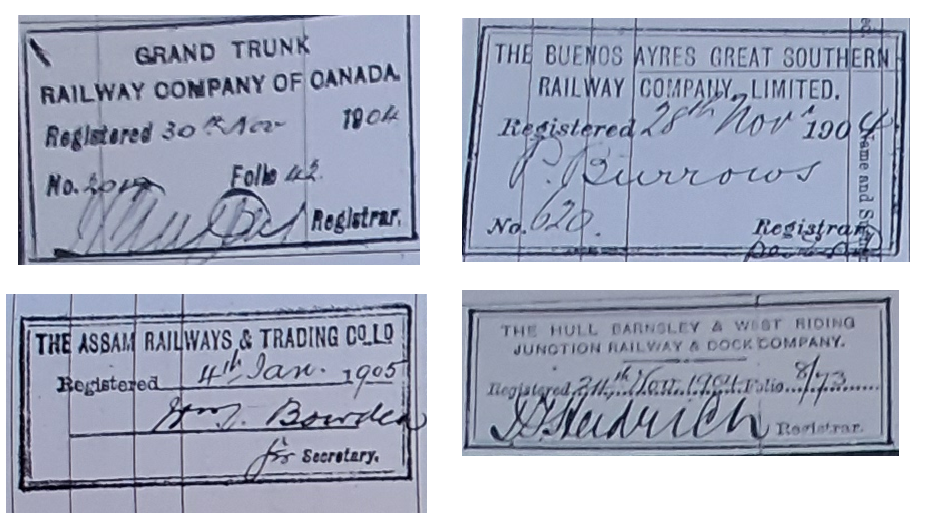I believe this is not to do with travel at all, but with shares in the companies named. My guess is that the wife held stock in each of those companies, and after changing her surname on marriage was obliged to inform the companies so that they could update their records. (Fallback guess: if the marriage was in 1882 or earlier, and this is just very late paperwork, then something else is going on, for which see below.) The marriage document was evidence for that, and would have been stamped by each company registrar as part of the process.
Some of the signatures come with the title "registrar", denoting a company officer responsible for keeping track of shareholders. Sometimes there is a "registrar of transfers" or other title; generically, this might be done by the company secretary in a smaller operation. British companies legislation from the 19th century (and all these companies were headquartered in the British Empire) imposed requirements of this kind as a condition of operating as a company.
When somebody sold shares, they were meant to do so by "deed of transfer" which would be delivered to the appropriate officer of the company. Until that deed was registered, the original shareholder was still on the hook if there were a call notice, and the intended new beneficiary would not receive any dividends. By legislation (the Companies Clauses Consolidation Act 1845, s.15), the deed of transfer would also receive an "endorsement" by the registrar to indicate that it had been recorded in the company's records.
Naturally, shares might also be transferred due to the death of the original shareholder, in which case there is no deed. But there was a similar process (same Act, s.18) for registering a declaration describing what had happened, plus the associated probate documents. Prior to the Married Women's Property Acts of 1881 (Scotland) and 1882 (England), a woman's stock would pass to her husband upon marriage, and there was also a process for registering that event, attested by the marriage certificate or similar document. If the marriage in question took place prior to the commencement date of those acts, then it was still possible for a consequent transfer to be registered.
However, on the assumption that the marriage was in 1904, this is probably a simpler clerical matter of updating the company register to refer to the woman's married name. I think what has happened in this case is that the woman named in the marriage document held shares in several railway companies. From late November 1904 through early January 1905, she and/or her husband filed the necessary paperwork with each company registrar in turn, including the marriage document. Each time, the registrar endorsed that document with a stamp as part of the recording process, as they would have done with a deed of transfer or anything else. The dates and identifying numbers would refer to entries in the company's registers.
I found a guidebook from 1893 which contains a standard form for filing change-of-name paperwork with the registrar. It also describes briefly that
On the marriage of a female proprietor the registrar should require a copy of the certificate of marriage, and a statutory declaration declaring the identity of the wife with the holder of the property, before registering the property in her married name.
This text also indicates the obsolesence of the transfer-on-marriage provisions, except for a marriage solemnized prior to the date I mentioned.
